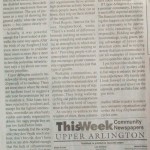ThisWeek UA 7/29/2009
A couple of years ago I had the honor of hearing Traci Parks speak about her life and work at a Tri-Village Rotary meeting. Traci Parks is a Columbus photographer with a special story: she is legally blind. She spoke about the challenges that disabled individuals face when trying to navigate neighborhoods and other public spaces.
Traci Parks photographs deficiencies in sidewalks and other pedestrian infrastructure. Through her photography she documents the types of deficiencies that many able-bodied individuals find to be an inconvenience. For the disabled however, these deficiencies are much more than an inconvenience. The use of pictures as a way of showing the general public what she experiences — but cannot clearly see — is powerful.
Actually, it was powerful enough that I never looked at sidewalks the same way again. After the birth of our daughter I had even more reason to consider these issues as more than a mere inconvenience. How we choose to develop pedestrian infrastructure says a lot about our community priorities.
Upper Arlington currently has sidewalks along approximately 20 percent of its roadway. There are some streets where the shoulder has been lined to suggest a safe zone for pedestrians but not to mandate it. Bike lanes have been rejected by residents and, except for the lighted intersections, crosswalks are often barely visible and rarely respected by drivers. For many people they are just two faded white lines.
Some residents find this acceptable; they don’t walk much anyhow, don’t bicycle, don’t have kids or are able-bodied enough that the lack of infrastructure doesn’t pose a problem. For them, crossing someone’s yard or using the roadway is a minor enough risk to take.
The arguments from residents against sidewalks and the like tend to fall into the categories of either cost or aesthetics.
There certainly is a large cost associated with installing these amenities; but then, what is the cost of not having this infrastructure? And isn’t there beauty in neighborhoods full of people walking, talking and biking?
Many of my peers have questioned my move to Upper Arlington. While they think it is a nice suburb (and it is) they don’t see it as being alive the way other local communities are. There’s not the kind of vibrant street life you see in Grandview, Worthington, Westerville or old Dublin; not to mention places like Clintonville or the Short North.
Healthy, vibrant communities are ones where residents have a maximum opportunity for interaction. People out walking, riding bikes, using public spaces for all sorts of activities — these are communities that encourage neighbors to engage each other and to meet the needs of individuals from within. Local businesses and organizations thrive around high pedestrian activity because, when people leave their car at home, they rely on them instead of the megamall, etc.
Fred Rogers, famous for his own Neighborhood, wrote, “There’s a world of difference between insisting on someone’s doing something and establishing an atmosphere in which that person can grow into wanting to do it.” Providing people with an atmosphere and infrastructure that encourages greater community engagement invites just that type of growth.
Walkable communities, as they’re often referred to, provide a focus on the implementation of complete streets as a way of supporting multiple transportation options. They bring walking, cycling and public transportation up to the same level of importance as the personal automobile.
As society re-embraces the wisdom of cities, those communities that reject this pedestrian orientation are finding it harder and harder to attract new residents and maintain their community identity. The generations that built our suburbs created the right community infrastructure for the time, but that time is passing.
To be fair, I am not without personal motivations here. I bought a home in Upper Arlington and want to make sure it remains a good investment. Now, several years on, Upper Arlington is losing population and its median age is rising. Even our excellent schools and libraries have taken some lumps.
If Upper Arlington is to remain a premier community, I believe it must offer superior amenities. The financial restrictions on making this happen are real but there is an opportunity to be innovative while remaining fiscally responsible. Holding neighborhood meetings, using grants, taking advantage of lower construction costs, and re-striping streets that can accommodate it are all examples of innovative and responsible ideas at work.
I put forward the challenge to residents and city leaders alike to find ways to enhance the pedestrian experience. My family and I look forward to sharing some conversation and space on the sidewalk, path and bike lane with you soon.
